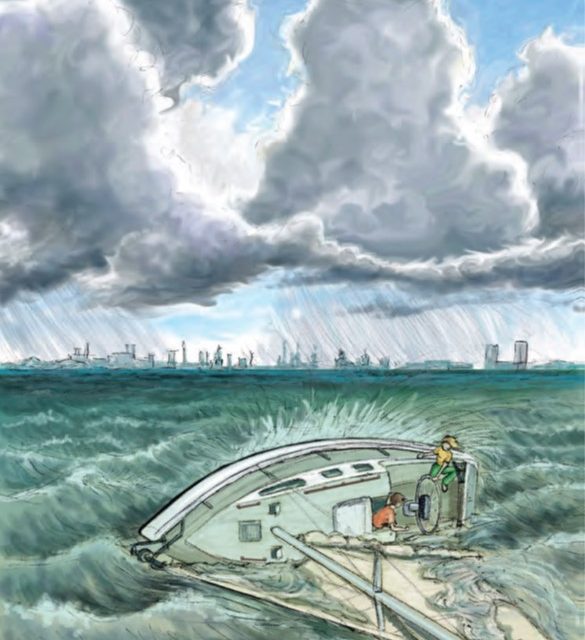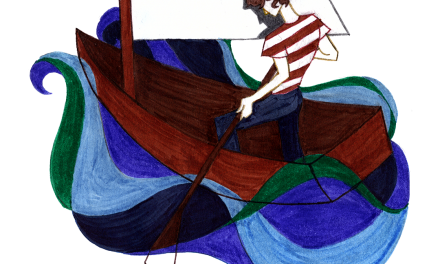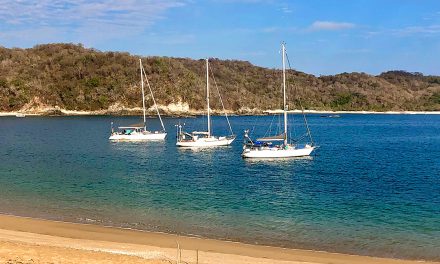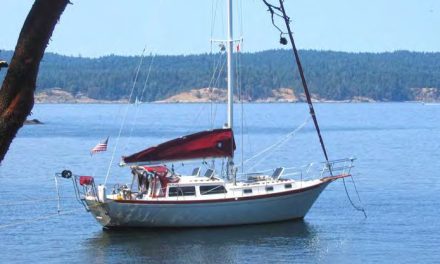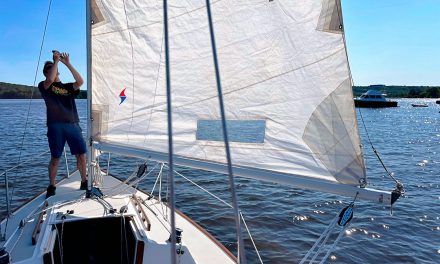A boisterous sail and a new boat make for a day full of lessons learned.
Issue 141: Nov/Dec 2021
“If you never make mistakes, you never learn anything.”
The first time I said this to my kid, I thought I had reached the pinnacle of parenting. As I walked away from his scowling teenaged face, I felt quite smug and superior.
Three years later, that line has come back to haunt me. I’m braced on the side of the starboard cockpit seat trying to sort out where the wind is coming from. My husband, Paul, is clinging to the companionway hatch. We’re both looking down at the surface of Lake Ontario, which is parallel to our mast and creeping up the sidedeck. This, I think, is why I should have closed the portholes before we left the marina.
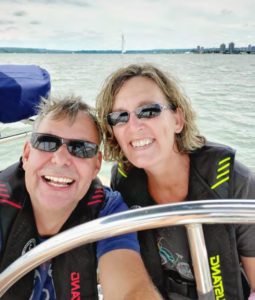 “Release the main!” I call to Paul. I’m behind the helm and tethered to the pushpit. The mainsheet is beside the companionway and beyond my grasp. I’d ease down the traveler to take some of the pressure off if I could, but I can’t; our traveler requires that both lines be released to make it work, and while I could grab the port traveler line—above my head in our current state— the starboard line is below my feet and out of reach.
“Release the main!” I call to Paul. I’m behind the helm and tethered to the pushpit. The mainsheet is beside the companionway and beyond my grasp. I’d ease down the traveler to take some of the pressure off if I could, but I can’t; our traveler requires that both lines be released to make it work, and while I could grab the port traveler line—above my head in our current state— the starboard line is below my feet and out of reach.
There’s a bang. Sweet Shoal, our 2004 Hunter 306, pops upright. She shudders. There’s a horrid rattling overhead. Paul has released the outhaul rather than the sheet. Since the mainsail is loose-footed, this has more or less the same result as easing the main, in that we’re no longer knocked down—but now the main is flailing madly.
I’m still trying to figure out where the wind is. We’re in this state because we were trying to practice how to heave-to. Now Sweet Shoal is facing the opposite direction; we must have jibed in the mayhem. Gradually, we get the boat under control and put everything back where it belongs. I get the bow into the wind, Paul tightens the outhaul, we fall away on a beam reach. Our speed climbs to a happy 6 knots. The folks on the powerboat and personal watercraft, who had been heading toward us slowly long enough for me to wave that we’re OK, give us a thumbs-up and pull away.
Once the cockpit is tidied up, we go over what happened. What did we do wrong? What can we do to make sure that doesn’t happen again?
We’ve had this conversation more than once since we bought Sweet Shoal in the fall of 2019.
In spite of how it seems, we are not novice sailors. My husband did some dinghy sailing when he was growing up in the Netherlands. At university, he sailed a 19th-century Dutch botter, a gaff-rigged, flat-bottomed sailing barge. My parents bought a Sirius 28 in 1983, and I learned to sail on her, as well as on a Sunfish and a Laser at the family cottage.
In 2008, Paul and I bought our first boat, a 1986 Sirius 22 named The June Edition. She was the perfect size for us and our three small children. We loved that boat, but she spent more time on the hard or at the dock than she deserved. Sailing with small children was, for us, a never-ending series of heart attacks. Keeping the kids entertained while they were confined to the cockpit or the cabin was a full-time job, and Paul, while he liked solo sailing, did not like solo sailing while listening to the kids argue.
Don’t get me wrong—we have some wonderful memories on June: two weeks in Georgian Bay’s Thirty Thousand Islands in the company of my parents’ Catalina 34, a spanking sail under headsail alone surfing through channel markers in Georgian Bay, and, just before we sold her, ghosting into our slip at LaSalle, Burlington, after sunset on Canada Day under main alone. When I stepped onto the dock to tie her up, our neighbors looked up from their conversation and noted how quiet our engine was.
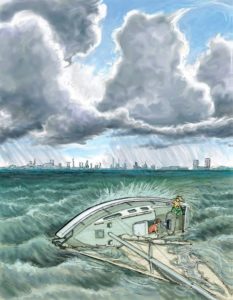
Illustration by Fritz Seegers
“It quit just outside the breakwall,” I said, proud of Paul, who had brought June in like a pro.
Maybe if we’d hit something, we wouldn’t have decided it was time for a bigger boat. But we hadn’t, and we did, which is how we ended up buying the Hunter 306 six weeks later. We sailed her precisely three times before she was hauled out and winterized, and we set to dreaming about the following summer: 2020.
So no, we weren’t novice sailors. We knew enough to know what we didn’t know. I found a local Sail Canada instructor who would give us lessons on our new boat. I enrolled in a full-day workshop on diesel engines. We were going to be prepared.
But, COVID. The diesel class was cancelled, the sailing instructor made his apologies, and when Sweet Shoal went into the water in June, we knew just as much about her as we had the previous fall.
We made quite a few mistakes, a combination of learning the boat and learning the water. The mainsail furling caused us some headaches, as did the engine. The west end of Lake Ontario can be really gusty due to wind funneling; the wind likes to jump on you unawares (especially when you’re still learning the water) from behind hills, large buildings, and the like. We’d be perfectly happy under full sail at 18 knots or so, then blammo, 24 knots. Gradually we learned how much steadier Sweet Shoal is when not overpowered. She’s a bit skittish under too much sail; she’s much more comfortable if we reef sooner and balances much more easily.
Still, we make it a point of practicing and trying to learn all the time, hence, the attempt—if botched—at heaving-to.
“Well,” I say, as we tidy up the boat and settle back down, “if you never make mistakes, you never learn anything.”
We’re in no rush and no one’s expecting us home, as we’ve told our (now adult) children that we’ll spend the night the boat. Our knockdown has spun us around, so we are facing Bronte Harbour in Oakville. The wind is favorable for a beam reach straight there, and like most boats, Sweet Shoal loves that point of sail. We have a bite to eat, and I fantasize about going all the way to Montreal for bagels (some 400 miles away across Lake Ontario and down the St. Lawrence River). As we get closer to Bronte, we join a flotilla of boats heading for the marina. It’s only 3 o’clock. The sailing is amazing. Why is everyone heading in?
We decide to tack, both to get out of their way and to head back home ourselves. As the jib peels across the bow, I see what the Oakville boats are running from.
The sky over Hamilton, our home port, is black with towering thunderstorms. The wind picks up. I get a single reef into the main, then stand on the cockpit seat to look forward. The storm looks nasty, but I’ve seen them blow right by us. Maybe this one will? But no, there’s a second stack of clouds, just as dark, and our course is right through the middle.
I lean back into the cockpit. “Remember how there weren’t many boats heading out from Hamilton today? Now we know why.”
Two minutes later we have a second reef in the main. The wind is gusting over 25 knots, but Sweet Shoal sails like a dream. She loves a starboard tack, and the westerly wind keeps the waves down. We’ve had the boat long enough that we feel confident in her, even if I am a little worried about the furling line for the jib, which I’d replaced a few days ago but am not sure I’ve done properly.
I yelp and laugh as a wave hits the bow, flings itself into the air, and hits me right in the face. Then I remember that the portholes are still open. Swearing like, well, a sailor, I duck below and begin closing them. Paul shouts something.
“I’ll be right there!” I finish closing the portholes and fight my way back into the cockpit. Paul says something about the jib. I glance at the wind indicator as another gust hits us. Thirty-five knots. We need to reef the jib.
Luckily, we’re on a starboard tack. We have two primary self-tailing winches, and we need one to control the jib sheet and the other to haul in the furling line. The furling line comes aft on the starboard side, so I control the sheet with the port winch and the furler with the starboard. We reef the jib. The boat settles. We’re doing over 7 knots on a double-reefed main and a reefed jib. The wind is 24 knots gusting to over 30.
We’re the only recreational boat on the water. The Burlington lift bridge, which grants entrance to Burlington Bay and Hamilton Harbor, is ahead. I’m a little nervous about waiting for the bridge in this wind, but as Paul says, we have to do it. The wind builds some more.
We reef the jib further, and now it takes both of us to do the job. Paul locks the helm to come help me, and while the boat balances well and keeps tracking, it’s nerve-wracking for those few moments to not have anyone at the helm in this wind.
I take a minute to catch my breath. Ahead of us is the bridge and the storm. Behind us? Behind us, a gigantic freighter.
“Let’s get the engine started,” Paul says. That would be the engine that’s been giving us grief. But it starts and stays started, and we furl the main. Then we furl the jib. Just as I finish the furl, the line goes slack. It’s come right out of the drum of the furler. Thankfully, when I’d furled the jib, I’d allowed the sheets to wrap around the sail a few turns, which is preventing it from flying open. I hurry forward with a length of line and secure it more firmly.
Then I notice that the lift bridge, which lifts on the hour and on the half hour, is wide open 20 minutes early. It has opened for the freighter behind us, which has right of way over pretty much everything except the storm.
“Yay!” I shout. There’s more than enough time for us to pass through the canal ahead of the ship, and as we enter Burlington Bay, the heavens open.
Without a jib, and with the wind right on our bow, we motor the last 4 miles home. We tie up, tidy up, dry off. The wind dies. The sun comes out. Our neighbor, a man with 50 years’ experience sailing this water, asks us about our day. I tell him, hoping we don’t sound too much like novices.
“Was there any yelling?” he asks with a smile.
I look at Paul, shake my head. “Nope. No yelling.”
“Good for you both,” he says. “Remember, you learn more from your mistakes!”
J.S. Veter is a writer and sailor from Hamilton, Ontario. Her short stories have appeared in On Spec Magazine, Beneath Ceaseless Skies, Exterus and others. She also writes gardening articles for Paradise Found, the member magazine for the Royal Botanical Gardens. She and her husband sail their 2004 Hunter 306, Sweet Shoal, out of Hamilton, Ontario.
Thank you to Sailrite Enterprises, Inc., for providing free access to back issues of Good Old Boat through intellectual property rights. Sailrite.com

